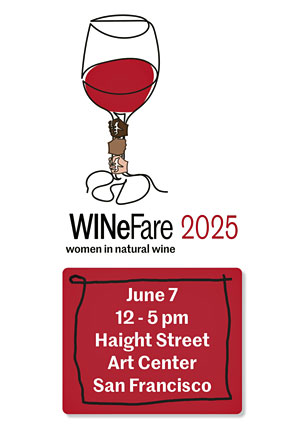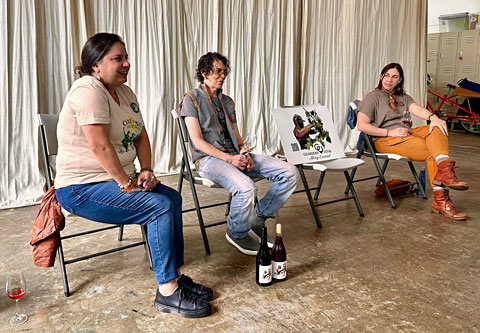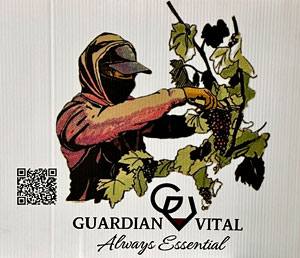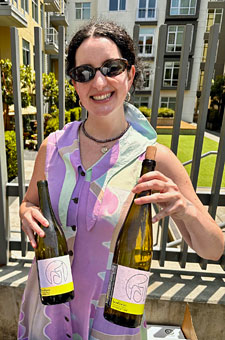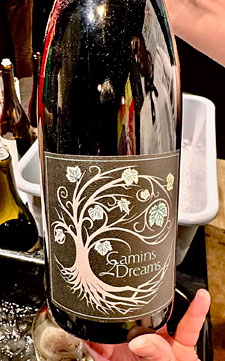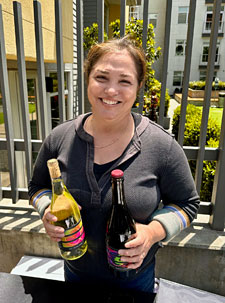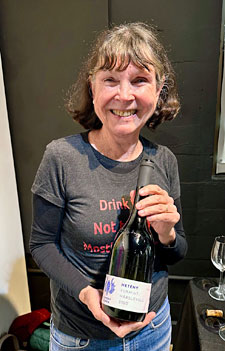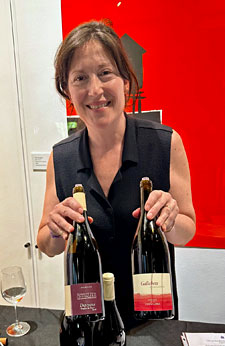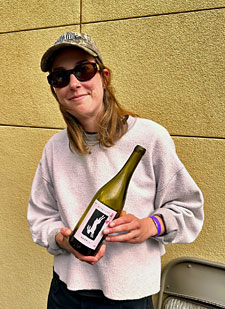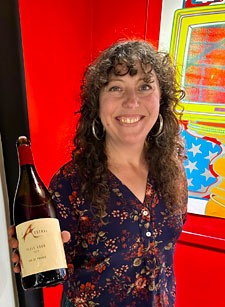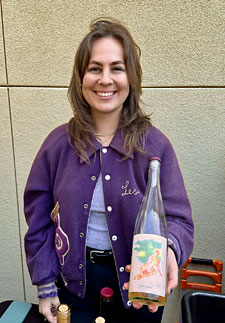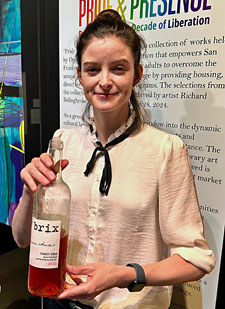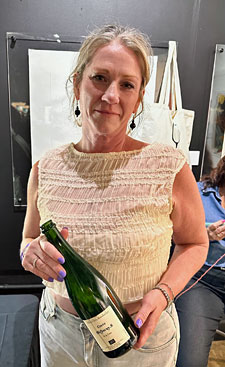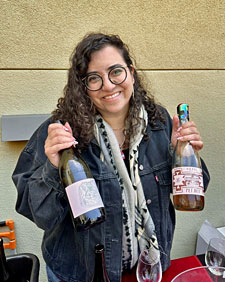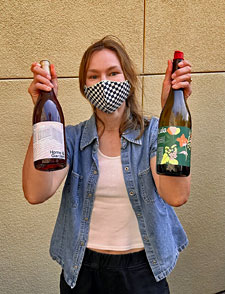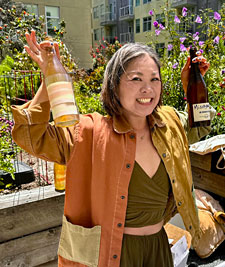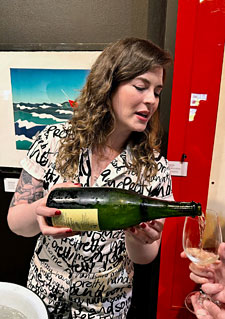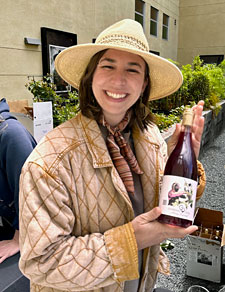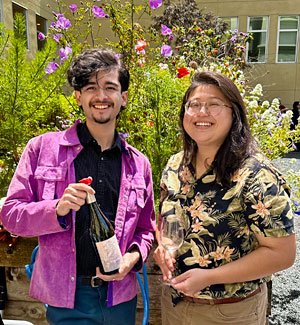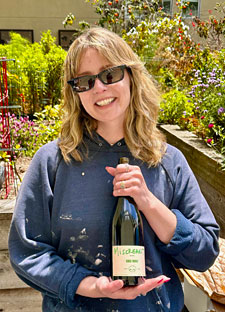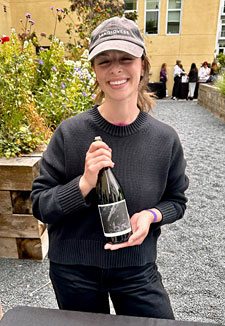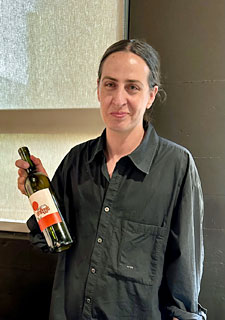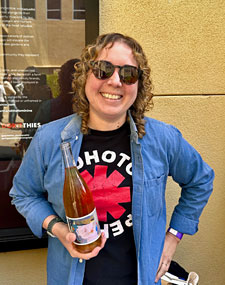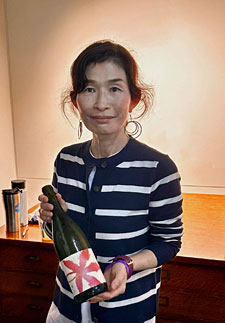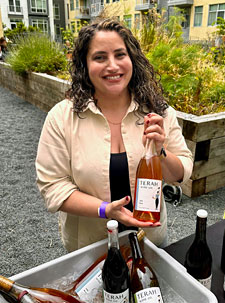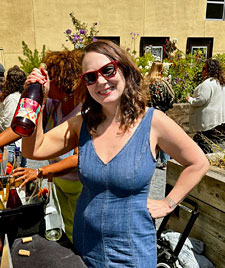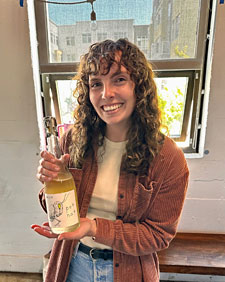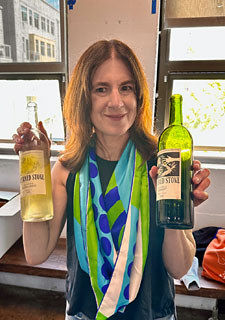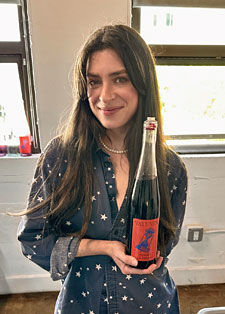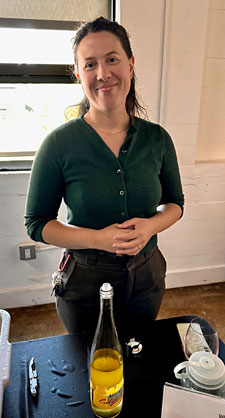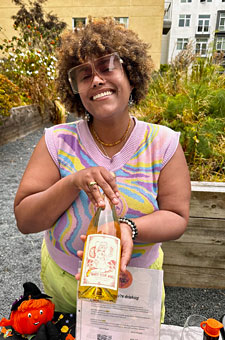Birdhorse Wines
Established in 2018, Birdhorse is the label of Corinne Rich and Katie Rouse. Both have worked at a number of wineries in the US and abroad, and currently have day jobs as assistant winemakers in Sonoma County. Sourced from Clements Hills in Lodi and made mostly in a concrete egg, the 2024 Vermentino was a favorite here, with bright citrus and floral notes, medium-light weight and vibrant acidity. The 2023 Valdiguié from Suisun Valley was another highlight, featuring bright and upfront red fruit, earth, and spice, with a pleasant texture and fairly mild tannins. The 2022 Shake Ridge Ranch Barbera from Amador County displayed red cherry fruit plus spice and dried herb notes – this has enough acidity that it should benefit from some additional time in the cellar.
Camins 2 Dreams
Founded in 2017 by Mireia Taribó and Tara Gomez, Camins 2 Dreams is based in Lompoc, California. They work with fruit from Santa Barbara County. As part of the morning forum, I tasted the Camins 2 Dreams “Guardian Vital” 2023 Christy & Wise Vineyard Syrah from Sta. Rita Hills. Blended with 18% Graciano, this wine was very meaty and savory, with both red and black fruit, a lively texture, and great structure for further aging. During the afternoon tasting, I tried the 2022 Donnachadh Vineyard Syrah from Sta. Rita Hills at the Amy Atwood Selections table. This was another savory wine with darker berry fruit, earth, and herb aromas with good acidity and moderate tannins.
Cary Q Wines
Cary Quintana is the owner / winemaker of her Cary Q label – she launched the winery in 2014 and currently makes her wines in Santa Rosa. Much of her fruit is sourced from the Sierra Foothills. A highlight was the 2023 “Perfect Storm” blend of 60% Grenache, 25% Mourvèdre, and 15% Tempranillo from Shake Ridge Ranch in Amador County, and fermented entirely with whole clusters. This featured floral red fruit aromas, spice, and earth, with fine structure for further development in the cellar. The 2023 “Crazy/Perfect” Cinsault from Fenaughty Vineyard in El Dorado County had black cherry and plum fruit, hints of flowers and fresh herbs, with lively acidity and a pleasant mouthfeel and finish.
Danch & Granger Selections
Eric Danch and Catherine Granger founded their import company in 2019 following the retirement of the owners of Blue Danube Wine Co. where they both worked, and they continue Blue Danube’s focus on the wines of Central and Eastern Europe. I particularly enjoyed the Homoky Dorka 2020 “Hetény,” a blend of Furmint and Hárslevelű from Tokaj in Hungary that was direct pressed and made in stainless steel. This had bright citrus and herb aromas with flowers and earth notes in support, medium-light bodied with a lively mouthfeel. The Pfneisl 2022 “Zweigler” Zweigelt from Burgenland in Austria displayed an earthy dark berry profile plus savory undertones, with plenty of structure.
Domaine de la Chevalerie
This family-run domaine was founded in 1640. They farm their 33-hectare vineyard of Cabernet Franc in the Loire Valley, and produce a number of bottlings from different portions of their vineyard which have different soil conditions. My favorite of the two wines I tasted here was the 2018 Bourgueil “Galichets” Cabernet Franc, featuring a savory herbal profile along with plum and currant fruit, earth, and stony mineral notes, with medium body and fine structure.
Etteilla Wines
Anne Disabato and Noelle Vandendriessche both worked for Tony Coturri before launching their own label, and they make their wines in Sonoma County. I especially liked the 2023 “SET” Carignan from 120-year old vines at Testa Vineyard in Mendocino County, made with partial carbonic and partial whole-cluster fermentation. Earthy raspberry and black cherry fruit plus touches of spice and pepper, this had a lively texture and moderate tannins.
Floraison Selections
Floraison Selections was founded in 2017 by Nadia Dmytriw, who has worked in the wine industry since 2001. Importers and distributors, they represent French producers from a number of regions. The Clos Fornelli “Clos Blanc” is 100% Vermentino from Corsica, direct-pressed and made in stainless steel – this had stone fruit and herb aromas with a vibrant mouthfeel and long finish. The Domaine de l’Austral 2022 “Octopus” Rouge Grolleau Noir from Saumur-Puy Notre Dame in the Loire Valley was whole-cluster fermented and aged in concrete. With earthy tart red fruit and spice upfront, this had good structure and moderate tannins.
Isa Wines
Originally from Italy, Isabella Morano came to California after finishing high school, and she worked as a sommelier and at several well-regarded wineries before starting her own label. I particularly liked her 2023 “Don’t Quit Your Day Job” Merlot from Massa Vineyard in Carmel Valley. With floral and slightly herbal and earthy red cherry fruit, this was a lighter-weight Merlot with a lively mouthfeel and long finish.
j. brix Wines
Based in Escondido in northern San Diego County, this is the label of husband-and-wife team Jody and Emily Towe. Their first commercial vintage was in 2010, and they source fruit mostly from the Central Coast and increasingly from vineyards in San Diego County. Skin-fermented for 14 days, the 2023 “Nomine Amoris” Skin-Contact Pinot Gris from Riverbench Vineyard in Santa Maria Valley was a standout here. Bright strawberry aromas plus notes of flowers, fresh herbs, and earth, this had a pleasant texture and finish. The 2021 “Audire” Pinot Noir from Kick On Ranch in Los Alamos in Santa Barbara County was destemmed prior to fermentation and aged in neutral oak – this featured a very savory profile, with black cherry, tea leaf, and a touch of spice, with good structure and a long finish.
Julie et Toby Bainbridge
American Julie and her English husband Toby live in Anjou in the Loire Valley, and farm a small vineyard there. They mainly work with Chenin Blanc, Grolleau, and Cabernet Franc. A blend of 50% each Cabernet Franc and Grolleau, the 2023 “Cuvée 50:50” displayed red and black fruit plus earth, herb, and floral undertones, with a lively texture and moderate tannins.
Kareen Wine
Kareen is the label of the Nemet family, who founded their winery in 2010. They produce a number of wines from Viognier to Malbec. My favorite at this table was the 2023 Barbera Pét-Nat from Shenandoah Valley in Amador County – this had subtle red fruit plus floral and herbal notes, with a bright mouthfeel and fine bubbles.
Laughing Gems
Tiffani Patton and Jonathan Yang are the proprietors of Laughing Gems, one of the newest wineries in the tasting. They make their wines in Richmond, California. My favorite of the two wines I tasted here was the 2024 “Super Fresh” Orange Muscat Pét-Nat from Lodi. Lightly sparkling, with bright but toned-down Muscat character along with floral notes, this was a fun wine with a lively texture and pleasant finish.
Loop de Loop
Located in the Columbia River Valley, Loop de Loop was launched in 2012 by winemaker Julia Bailey. Their estate vineyard practices organic and regenerative farming. My favorite here was the 2022 Columbia Gorge Chardonnay, aged in stainless steel and neutral oak. Displaying pear and stone fruit along with floral and herbal notes, this had medium weight on the palate with good acidity.
Lula
Megan Sekermestrovich launched her Lula label with the 2019 vintage, and she makes her wines in Richmond, California. I especially liked her 2023 “State Flower” Valdiguié from Redwood Valley in Mendocino County. With bright black cherry and plum fruit plus floral and herbal undertones, this had a juicy mouthfeel and finish.
Maison des Plaisances
Owner/winemaker Coral Wang makes her wines in Sonoma, and also farms a vineyard in Sonoma County’s Lovall Valley. Her 2023 “Étienne” Sauvignon Blanc from Sonoma Valley was a highlight – this spent about a week on the skins and then seven months in amphora. The wine was herbal and savory with subtle citrus and apple notes and a mildly tannic grip on the finish. Sales of the 2023 “Around the Way Girl” – a blend of 50% Zinfandel plus 50% orange wine of Louriero, Falanghina, and Cortese – help to benefit San Francisco’s 280 Project. This was a fun wine, with bright and savory red fruit, lively texture, and moderate tannins.
|
Maloof Wines
Bee and Ross Maloof established their Oregon winery in 2015, and they farm an estate vineyard in Willamette Valley. My favorite at this table was the 2023 “Where Ya PJs At?” blend of 80% skin-fermented Pinot Gris from the Dundee Hills and 20% barrel-fermented dry Riesling. This featured tart red fruit and citrus aromas plus earth and spice undertones, with medium-light body, pleasant mouthfeel, and a long finish.
Margins Wine
Megan Bell launched her label in 2016, after working in wineries and vineyards in California, Oregon, New Zealand and the Loire Valley. She makes her wines in Santa Cruz County. As part of the morning forum I tasted the Margins “Guardian Vital” 2024 Red Wine, a blend of Assyrtiko and Pinot Noir from Paicines Ranch in San Benito Count. This was a fun blend featuring stone fruit and mildly floral aromas, with great acidity. Then during the afternoon tasting I tried the 2024 Paicines Ranch Assyrtiko, with citrus, herb, and floral notes and a lively mouthfeel. Another noteworthy wine was the 2024 Paicines Ranch Grenache, which was bright and juicy, with red fruit and savory herbal character and good structure.
Matthiasson Wines
Napa-based viticulturist Steve Matthiasson and his wife Jill produced their first commercial vintage in 2003. In addition to purchased fruit, they also have their own Napa vineyard, which includes Ribolla Gialla, Refosco, Schioppettino, Merlot, and Petit Verdot. Sourced from two vineyards and made with a little skin contact, the 2023 North Coast Chenin Blanc displayed subtle pear and stone fruit aromas with good acidity and a pleasant mouthfeel. The 2022 Old Vine Zinfandel from Sonoma Valley was a lighter and brighter take on this variety, with red fruit and herb notes and a lively texture. The 2022 Santa Cruz Mountains Syrah from Zayante Vineyard was fermented entirely with whole clusters and had a very savory profile, with herbs, red fruit, spice, and a slight floral touch, with great structure for additional development.
Miscreant Wines
Kath and Jaz of Miscreant make their wines in Richmond, California. Their 2023 “Good Work!” Pinot Noir from Rodnick Farm in Monterey County’s Chalone AVA was my favorite of their wines – it displayed savory red fruit and a forest floor / umami note, with lively acidity and fine tannins.
Osa Major Wines
Osa Major owner/winemaker Emily Fernwood worked harvests all over the world before launching her own label in 2020. She makes her wines in Berkeley. I thought that the 2023 “Gold in the Hills” Sémillon from Chatom Vineyard in Calaveras County was a standout, with pear and spice aromas and great texture. I also particularly enjoyed the 2023 Russian River Valley Pinot Noir, which displayed tart red fruit, earth, and herb notes with good structure. The 2023 Syrah from Poor Ranch in Mendocino County was another highlight – fermented with 50% whole clusters, this had very savory red fruit plus hints of flowers and spice, with plenty of structure for additional development in the cellar.
Roni Selects
Roni Ginash launched her Los Angeles-based import and distribution company in 2017. Roni Selects represents wineries from the US, France, Germany, Italy, and Georgia. My favorite here was the Kortavebis Marani 2023 “Selects” blend of 95% Rkatsiteli and 5% Kisi from Kakheti in Georgia, fermented for one month on the skins and aged a further nine months in qvevri. With earth and spice aromas upfront plus stone fruit in support, this had lots of texture on the palate with moderate tannins on the finish.
Ruby Blanca Wines
Sabrina Tamayo worked at several wineries for harvest / crush before launching her Ruby Blanca label in 2021, and she makes her wines in Richmond, California. A standout here was the 2023 Skin-Fermented Ribolla Gialla from Il Mio Vigneto Vineyard in the Clements Hills region of Lodi, fermented for three weeks on the skins. This featured aromas of citrus and stone fruit, orangepeel, and spice, with great texture and enough structure for some additional aging. The 2023 Barbera from Mendocino County was made partially with carbonic fermentation, and had bright red fruit along with earth and spice notes, with plenty of acidity and fine tannins.
Six Cloves Wines
Originally from Nagano, Japan, owner/winemaker Sonoe Hirabayashi has worked for wineries in Napa, Sonoma, New Zealand, and Chile. Her first vintage was in 2017 and she makes her wines in Sonoma County. Sourced from the Oak Knoll District in the cooler southern part of Napa Valley, the 2023 Linda Vista Vineyard Chardonnay was one of my favorites at this table – bright pear and apple fruit with undertones of spice and flowers, medium-bodied with a pleasant texture and long finish. The 2023 Buf-Wehr Vineyard Pinot Noir from Russian River Valley was savory and earthy, displaying red fruit and tea leaf aromas plus a floral touch, with fine acidity and a lively finish.
Terah Wines
A certified sommelier as well as a winemaker, Terah Bajjalieh worked in the restaurant business, wine education, and worked over a dozen winegrape harvests in California, Oregon, France, Argentina, Australia, and New Zealand. She launched her wine label in 2020. I especially enjoyed her 2024 Vermentino from Clements Hills in Lodi with its bright floral and stone fruit aromas and vibrant texture. The 2023 Red Wine, a co-ferment of Syrah and Grenache from Santa Clara Valley, was another favorite, displaying bright red fruit, spice, and earth, with the structure for some time in the cellar.
Tessier Winery
Tessier owner / winemaker Kristie Tacey has a background as a research scientist, and she established the Tessier label with the 2009 vintage. She makes her wines in Berkeley and produces a number of varietal wines and blends. I enjoyed her 2024 “Electric Ladyland” white/red blend though the 2024 “Soul Love” blend of 60% Riesling, 30% Gamay, and 10% Mourvèdre was my favorite of these two – this one featured both stone fruit and red berry fruit, flowers, and spice, with a lively texture and long finish. The 2024 Gamay from Barsotti Vineyard in El Dorado County was also noteworthy – fermented with 50% whole clusters, this had earthy black cherry and plum aromas with herbal undertones and good structure.
Thacher Winery and Vineyard
Founded in 2004, the family-run winery is located in Paso Robles and they work with fruit from the Central Coast, including their organically-farmed estate vineyard. Assistant winemaker Brenna Hill was on hand at the tasting. The 2024 Pét-Nat from the estate vineyard includes 40% Grenache, 40% Cinsaut, and 20% Viognier – this had pear and stone fruit aromas plus floral notes, with light bubbles. Skin-fermented in amphora for five weeks, the 2023 Muscat Canelli from Monterey County displayed subtle floral Muscat aromas, with medium-light weight and a pleasant texture.
Unturned Stone Wine
Unturned Stone was launched in 2010 by Erin Mitchell and Randy Czech. They make their wine in Windsor, and they focus on vineyard sources in Sonoma and Mendocino counties. I thought the highlight here was the 2023 “Moonwater” Merlot from Bennett Valley. With black cherry fruit, herbs, and a touch of spice, this was medium-bodied with a lively mouthfeel and moderate tannins.
Vai e Vem Wine
Ully Pòvoa was born in Brazil but grew up in California, and founded her Vai e Vem (“Come and Go” in Portuguese) label in 2021. She makes her wine in Sonoma. My favorite at her table was the skin-fermented 2021 “The End is Infinite” Dornfelder from Mokelumne Glen Vineyard in Lodi. A lighter and brighter rendition of the variety, this had earthy dark berry fruit and spice aromas, with good structure and moderate tannins.
Virgo Magic Wines
Olivia “Liv” Ross worked at several noted wineries after earning a degree in viticulture and enology and before launching her Virgo Magic label in 2020. A standout was the 2022 “Motel California” – a blend of 65% Orange Muscat and 35% Fiano from Hartwick Vineyard in Lodi, which featured subtle floral aromas along with stone fruit and tropical fruit notes and a lively mouthfeel. The 2023 “Á La Volée” Sparkling Riesling from Wirz Vineyard in San Benito County’s Cienega Valley had bright citrus, stone fruit, and mildly floral notes, with fine acidity and light but persistent bubbles.
Ward Four Wines
Justin Michelle Ward Trabue is from Washington DC and she started her Ward Four label after working for wineries in Australia and the US as well as earning a wine business degree. She makes her wine in Sonoma. Her 2024 Mourvèdre Rosé from Shake Ridge Ranch in Amador County was one of my favorite rosé wines of the day, with juicy watermelon and red fruit, a slightly savory herbal note, and bright acidity. The 2023 Petite Sirah from Grist Vineyard in Dry Creek Valley, aged in older barrels for 18 months, displayed dark berry fruit along with touches of flowers and pepper, and fine tannins on the finish.
|


